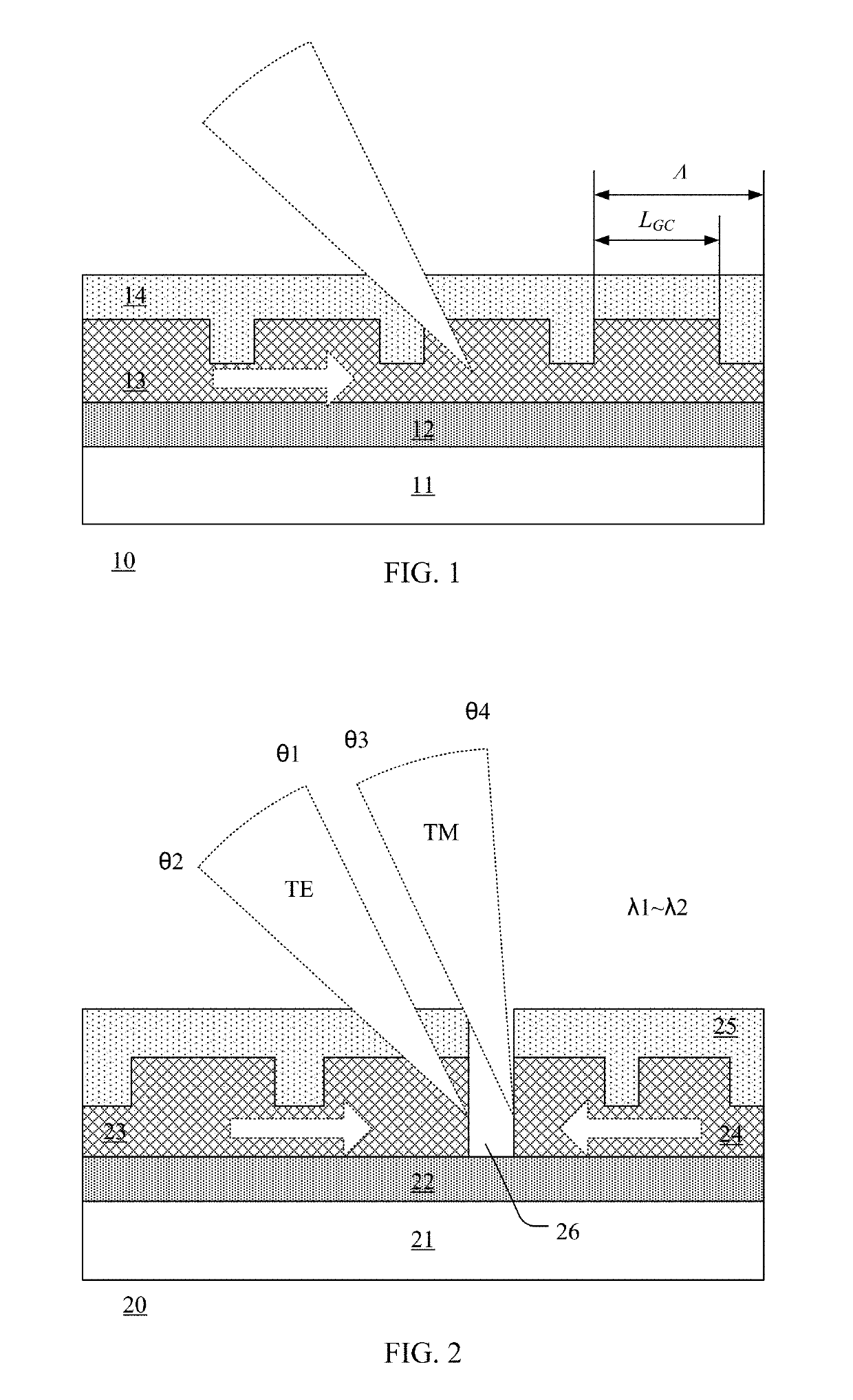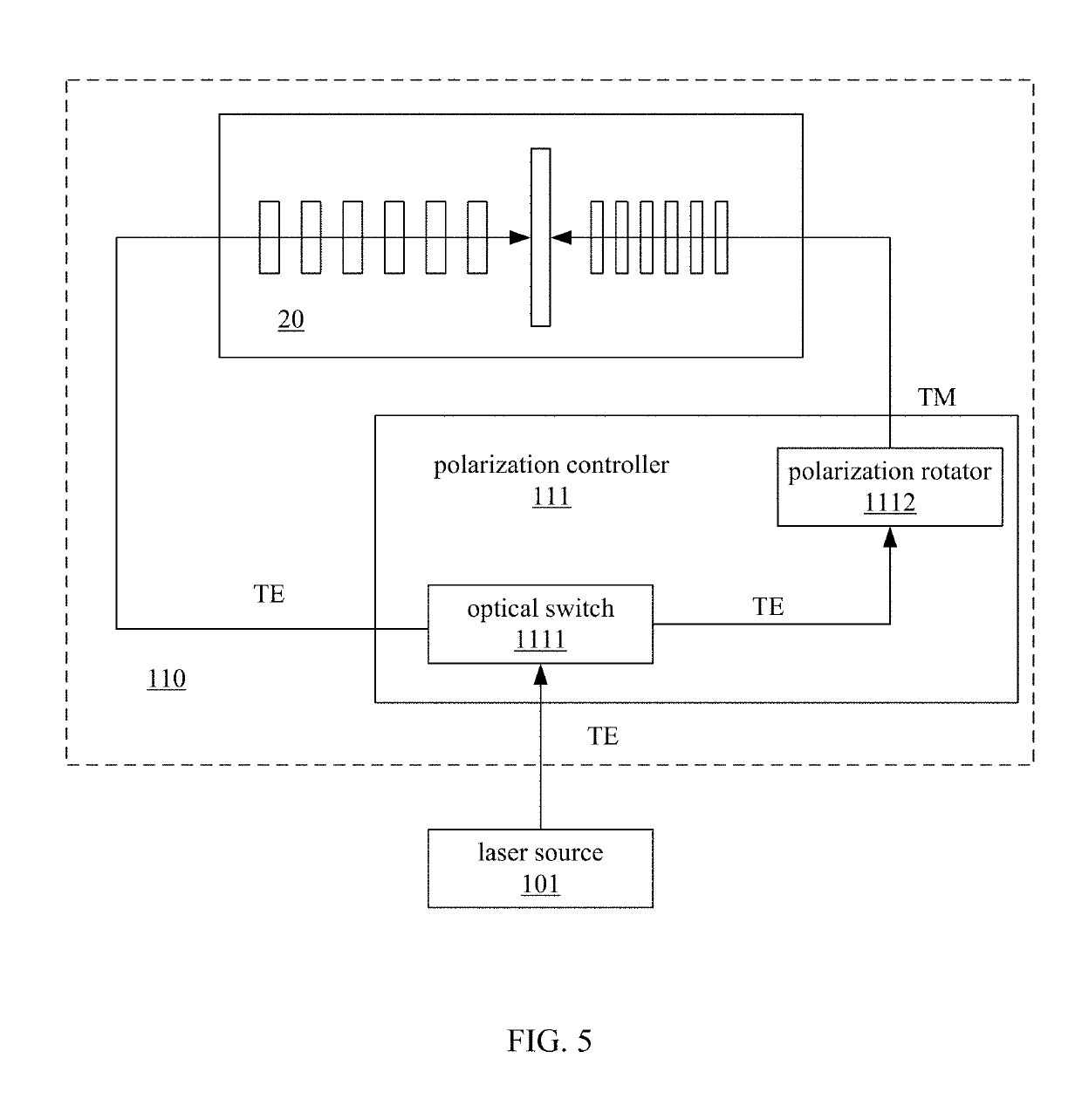GRATING DEVICE, LIGHT-EMITTING UNIT and LIGHT DETECTION METHOD
a light-emitting unit and grating technology, applied in the field of grating devices and light-emitting units, can solve the problems of narrow wavelength range only being translated to narrow or moderate angle range, conventional lidar needs an expensive opto-mechanical system to enlarge the detection range, and achieve the effect of enhancing the intensity of reflected beams
- Summary
- Abstract
- Description
- Claims
- Application Information
AI Technical Summary
Benefits of technology
Problems solved by technology
Method used
Image
Examples
first embodiment
[0082]FIG. 2 is a cross-sectional view showing a grating device according to the present disclosure. The grating device 20 includes a substrate 21, a blocking layer 22 on the substrate 21, a first waveguide 23 and a second waveguide 24 on the blocking layer 22, and a cladding layer 25 on the first waveguide 23 and the second waveguide 24. Preferably, the grating device 20 further includes a gap 26 which separates the first waveguide 23 from the second waveguide 24.
[0083]The substrate 21 may be made of silicon, on which semiconductor devices such as transistors may also be formed. Thus, the grating device may be integrated with a signal processing circuit as a single lidar chip.
[0084]The blocking layer 22 may be formed between the substrate 21 and the first waveguide 23 and the second waveguide 24 so as to confine a laser beam to propagate through the first waveguide 23 and the second waveguide 24. The blocking layer is made of, for example, silicon oxide.
[0085]Each of the first wave...
second embodiment
[0103]FIG. 5 is a cross-sectional view showing a light-emitting unit according to the present disclosure. A light-emitting unit 110 includes a grating device 20 and a polarization controller 111.
[0104]The grating device 20 has a structure shown in FIG. 2, and includes a first waveguide 23 and a second waveguide 24.
[0105]A laser source 101 may generate a source beam of a TE mode, as a first input beam. The polarization controller 111 generates a second input beam of a TM mode from the source beam. Moreover, the polarization controller 111 may select one of the first and second input beams.
[0106]The grating device 20 is coupled to the polarization controller 111 laser. The first waveguide 23 receives the first input beam of the TE mode, and the second waveguide 24 receives the second beam of the TM mode. Two output beams are generated by steering the first and second input beams by diffraction respectively, with different steering angles, at least, at one wavelength.
[0107]In this embo...
third embodiment
[0110]FIG. 6 is a cross-sectional view showing a light-emitting unit according to the present disclosure. A light-emitting unit 210 includes a plurality of grating devices 20, a polarization controller 111, a first beam splitter 211, and a second beam splitter 212.
[0111]The plurality of grating devices 20 are aligned in an array, and preferably, share a common substrate and a common blocking layer in a single chip. Each of the plurality of grating devices 20 has a structure shown in FIG. 2, and includes a first waveguide 23 and a second waveguide 24.
[0112]A laser source 101 may generate a source beam of a TE mode, as a first input beam. The polarization controller 111 generates a second input beam of a TM mode from the source beam. Moreover, the polarization controller 111 may select one of the first and second input beams. The light source 101 and polarization controller 111 in the light-emitting unit according to the third embodiment are the same as those in the second embodiment,...
PUM
| Property | Measurement | Unit |
|---|---|---|
| wavelength range | aaaaa | aaaaa |
| width | aaaaa | aaaaa |
| wavelengths | aaaaa | aaaaa |
Abstract
Description
Claims
Application Information
 Login to View More
Login to View More - R&D
- Intellectual Property
- Life Sciences
- Materials
- Tech Scout
- Unparalleled Data Quality
- Higher Quality Content
- 60% Fewer Hallucinations
Browse by: Latest US Patents, China's latest patents, Technical Efficacy Thesaurus, Application Domain, Technology Topic, Popular Technical Reports.
© 2025 PatSnap. All rights reserved.Legal|Privacy policy|Modern Slavery Act Transparency Statement|Sitemap|About US| Contact US: help@patsnap.com



